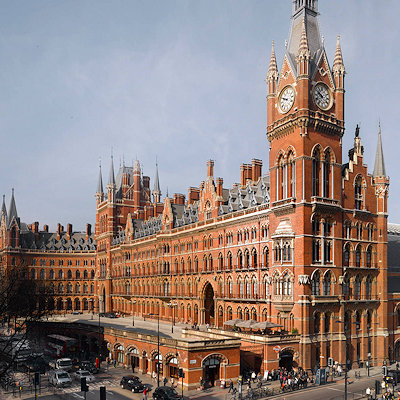
Like us on Facebook
PLACE NAMES


 
|
|
Saint Pancras
|

| |
 | Piccadilly Circus Underground - 0343 222 1234
King's Cross Underground station, Western Ticket Hall near St Pancras
visit@cityoflondon.gov.uk
|
The district now encompassed by the term "St Pancras" is not easy to define, and its usage as a place name is fairly limited. The name is sometimes applied to the immediate vicinity of the eponymous railway station, but King's Cross is the usual name for the area around the two mainline stations as a whole.
St Pancras was originally a medieval parish, which ran from close to what is now Oxford Street north as far as Highgate, and from what is now Regent's Park in the west to the road now known as York Way in the east, boundaries which take in much of the current London Borough of Camden, including its central part. However, as the choice of name for the borough suggests, St Pancras has lost its status as the central settlement in the area.
The original focus of the area was the church, now known by the retronym of St Pancras Old Church. The building is in the southern half of the parish, and is believed by many to be one of the oldest sites of Christian worship in Great Britain. However, in the 14th century the population moved en masse to Kentish Town, probably due to flooding by the River Fleet and the availability of better wells at the new location. A chapel of ease was established there, and the old settlement was abandoned, except for a few farms, until the growth of London in the late eighteenth century.
In the 1790s Earl Camden began to develop some fields to the north and west of the old church as Camden Town. About the same time, a residential district was built to the south and east of the church, usually known as Somers Town. In 1822 the new church of St Pancras was dedicated as the parish church. The site was chosen on what was then called the New Road, now Euston Road, which had been built as London's first bypass, the M25 of its day. The two sites are about a kilometer apart. The new church is Grade I listed for its Greek Revival style; the old church was rebuilt in 1847. In the mid 19th century two major railway stations were built to the south of the Old Church, first Kings Cross and later St Pancras. The new church is closer to Euston Station.
By the end of the nineteenth century the ancient parish had been divided into 37 parishes, including one for the old church. There are currently 17 Church of England parishes completely contained within the boundaries of the ancient parish, all of which benefit from the distributions from the St Pancras Lands Trust, and most of which are in South Camden Deanery in the Edmonton Area of the Diocese of London.
Old St Pancras Church and its graveyard have links to Charles Dickens, Thomas Hardy, and the Wollstonecraft circle. Immediately to the north of the churchyard is St Pancras Hospital, originally the parish workhouse and latterly the London Hospital for Tropical Diseases. St Pancras is one of the best-known railway stations in England. It has been extended and is now the terminus for the Eurostar services through the Channel Tunnel.
|
 Feel free to Email me any additions or corrections Feel free to Email me any additions or corrections
LINKS AVAILABLE TO YOUR SITE
| |





